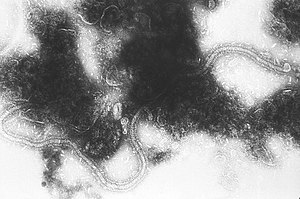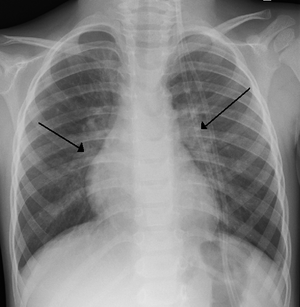Respiratory syncytial virus
| Human respiratory syncytial virus (HRSV) | |
|---|---|
 |
|
| Transmission electron micrograph of RSV | |
| Virus classification | |
| Group: | Group V ((-)ssRNA) |
| Order: | Mononegavirales |
| Family: | Paramyxoviridae |
| Genus: | Orthopneumovirus |
| Species: | Human respiratory syncytial virus |
| Human respiratory syncytial virus infection |
|
|---|---|
 |
|
| An x ray of a child with HRSV showing the typical bilateral perihilar fullness | |
| Classification and external resources | |
| Specialty | Pediatrics |
| ICD-10 | B97.4, J12.1, J20.5, J21.0 |
| ICD-9-CM | 079.6 |
| DiseasesDB | 11387 |
| MedlinePlus | 001564 |
| eMedicine | ped/2706 |
| MeSH | D018357 |
Human respiratory syncytial virus (HRSV) is a syncytial virus that causes respiratory tract infections. It is a major cause of lower respiratory tract infections and hospital visits during infancy and childhood. A prophylactic medication, palivizumab, can be employed to prevent HRSV in preterm (under 35 weeks gestation) infants, infants with certain congenital heart defects (CHD) or bronchopulmonary dysplasia (BPD), and infants with congenital malformations of the airway. Treatment is limited to supportive care (e.g. C-PAP), including oxygen therapy.
In temperate climates there is an annual epidemic during the winter months. In tropical climates, infection is most common during the rainy season.
In the United States, 60% of infants are infected during their first HRSV season, and nearly all children will have been infected with the virus by 2–3 years of age. Of those infected with RSV, 2–3% will develop bronchiolitis, necessitating hospitalization. Natural infection with HRSV induces protective immunity which wanes over time—possibly more so than other respiratory viral infections—and thus people can be infected multiple times. Sometimes an infant can become symptomatically infected more than once, even within a single HRSV season. Severe HRSV infections have increasingly been found among elderly patients. Young adults can be re-infected every five to seven years, with symptoms looking like a sinus infection or a cold (infections can also be asymptomatic).
The incubation time (from infection until symptoms arrive) is 4–5 days. For adults, HRSV produces mainly mild symptoms, often indistinguishable from common colds and minor illnesses. The Centers for Disease Control consider HRSV to be the "most common cause of bronchiolitis (inflammation of the small airways in the lung) and pneumonia in children under 1 year of age in the United States". For some children, RSV can cause bronchiolitis, leading to severe respiratory illness requiring hospitalization and, rarely, causing death. This is more likely to occur in patients that are immunocompromised or infants born prematurely. Other HRSV symptoms common among infants include listlessness, poor or diminished appetite, and a possible fever.
...
Wikipedia
